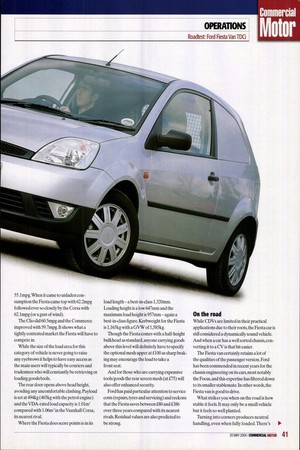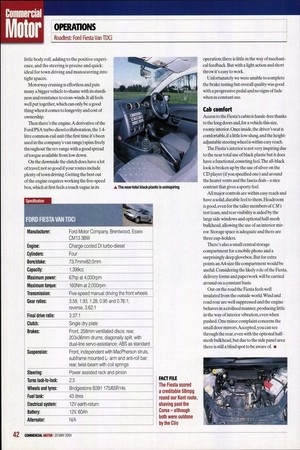BOUNC
Page 38

Page 39

Page 40

If you've noticed an error in this article please click here to report it so we can fix it.
BACK
After two years out of the game the Fiesta Van is back — but with plenty of alternative CDVs out there will the all-new model be
able to re-establish itself?
Two years is a long time in the world of commercial vehicles, especially if your name's Ford. Such is the size and reputation of the company that it's taken as a matter of course that when it comes to overall light CV sales figures the blue oval will be out in front, and the vehicles themselves will be there or thereabouts when it comes to performance.
But since January 2002 it has been without a replacement for the Fiesta Van and, as the saying goes, time waits for no man. Buyers have inevitably looked elsewhere and the market is now dominated by the Peugeot 206 and Vauxhall Corsavan with 32% and 25% respectively—in 1999 the Fiesta van held a predominant 65%.
But now Ford has returned with an all-new model, based on the Fiesta passenger car.
One of drawbacks with CDVs is that they're not originally designed with commercial tasks in mind.That may limit their appeal in some people's minds, where payload and space are the key factors. But if you carry a basic array of tools or light materials, need to zip around in town traffic and park up at a moment's notice, these vehicles provide a practical balance of size and space. A brief look at the spec and price confirms that Ford has done its homework.The range has been kept simple with just two engine options: a 1.4-litre TDCi producing 67hp and
160Nm, and a Duratec 1.3-litre petrol unit with 69hp and 106Nm on tap. Ford expects 95% of sales to be diesels.
You certainly can't fault Ford for lack of ambition—it aims to sell 4,000 vehicles a year in a market that totalled 6,285 in 2002, and has priced its new baby accordingly.
The petrol version starts at £.8,650 while the diesel is £9,000— both are on-the-road prices. This just beats the Vauxhall Corsa, which is £8,695 list or £9,289 on the road (though it is an older vehicle) and the Rover Commerce at £8,264/£10,395.The company will not be producing an LPG option, though there are a number of independent companies who will be able to handle conversions.
Standard equipment is also generous for a vehicle in this class, including ABS, driver and passenger airbags, immobiliser, remote control central/double locking and a halfheight full-width bulkhead (we won't mention the standard radio-cassette player). In fact options are kept to a minimum, partly because everything you need (besides a CD player and alarm) comes with the basic model.
But for those who need that little bit extra, side airbags, metallic paint, air-con and a mesh upper for the bulkhead can also be requested.
And for £150 extra you get the 'Convenience Pack', which comprises electrically operated and heated door mirrors and electrically operated front windows.
The Fiesta Van comes backed by a threeyear/60,000-mile warranty and 95 'Backbone' dealerships around the country which specialise in CVs and the particular needs of customers in this sector. Productivity
With a vehicle this size, especially in diesel guise, you've got to expect decent fuel economy.And 58.0mpg for a laden run around our Kent test route doesn't disappoint; it compares favourably with the Corsa's 57.7mpg (CM 1 April 04), though both were outdone by Renault's Clio with 58.7mpg (CM 28 March 02). Bringing up the rear was the Rover Commerce 2.0TD (bigger engine accepted) with
55.1mpg.When it came to unladen consumption the Fiesta came top with 62.2mpg followed ever so closely by the Corsa with 62.1mpg (or a gust of wind).
The Clio did 60.5mpg and the Commerce improved with 59.7mpg. It shows what a tightly contested market the Fiesta will have to compete in.
While the size of the load area for this category of vehicle is never going to raise any eyebrows it helps to have easy access as the main users will typically be couriers and tradesmen who will constantly be retrieving or loading goods/tools.
The rear door opens above head height, avoiding any uncomfortable clashing. Payload is set at 494kg (465kg with the petrol engine) and the VDA-rated load capacity is 1.01m' compared with 1.06m' in the Vauxhall Corsa, its nearest rival. Where the Fiesta does score points is in its
load length— a best-in-class 1,320mm. Loading height is a low 647mm and the maximum load height is 957mm — again a best-in-class figure. Kerbweight for the Fiesta is 1,165kg with a GVW of 1,585kg. Though the Fiesta comes with a half-height bulkhead as standard, anyone carrying goods above this level will definitely have to specify the optional mesh upper at £100 as sharp braking may encourage the load to take a
front seat.
And for those who are carrying expensive tools/goods the rear screen mesh (at £75) will also offer enhanced security.
Ford has paid particular attention to service costs (repairs, tyres and servicing) and reckons that the Fiesta saves between £80 and £386 over three years compared with its nearest rivals. Residual values are also predicted to be strong. On the road
While CDVs are limited in their practical applications due to their roots, the Fiesta car is still considered a dynamically sound vehicle. And when a car has a well sorted chassis, converting it to a CV is that bit easier.
The Fiesta van certainly retains a lot of the qualities of the passenger version. Ford has been commended in recent years for the chassis engineering on its cars, most notably the Focus, and this expertise has filtered down to its smaller stablemate. In other words, the Fiesta van is good to drive.
What strikes you when on the road is how stable it feels. It may only be a small vehicle but it feels so well planted. Turning into corners produces neutral handling, even when fully loaded. There's
little body roll, adding to the positive experience, and the steering is precise and quick: ideal for town driving and manoeuvring into tight spaces.
Motorway cruising is effortless and puts many a bigger vehicle to shame with its sturdiness and resistance to cross-winds. It all feels well put together, which can only be a good thing when it comes to longevity and cost of ownership.
Then there's the engine.A derivative of the Ford/PSA turbo-diesel collaboration, the 1.4litre common-rail unit (the first time it's been used in the company's van range) spins freely throughout the rev range with a good spread of torque available from low down. On the downside the clutch does have a lot of travel; not so good if your routes include plenty of town driving. Getting the best out of the engine requires working the five-speed box, which at first feels a touch vague in its
operation; there is little in the way of mechanical feedback. But with a light action and short throw it's easy to work.
Unfortunately we were unable to complete the brake testing but overall quality was good with a progressive pedal and no signs of fade when in constant use. Cab comfort
Access to the Fiesta's cabin is hassle-free thanks to the long doors and, for a vehicle this size, roomy interior. Once inside, the driver's seat is comfortable, if a little low-slung, and the heightadjustable steering wheel is within easy reach.
The Fiesta's interior is not very inspiring due to the near total use of black plastic but it does have a functional, cosseting feel. The all-black look is broken up by the use of silver on the CD player (if you specified one) and around the heater vents and the fascia dials — a nice contrast that gives a sporty feel.
All major controls are within easy reach and have a solid, durable feel to them. Headroom is good, even for the taller members of CM'S test team, and rear visibility is aided by the large side windows and optional half-mesh bulkhead, allowing the use of an interior mirror. Storage space is adequate and there are three cup-holders.
There's also a small central storage compartment for a mobile phone and a surprisingly deep glovebox. But for extra points an A4-size file compartment would be useful. Considering the likely role of the Fiesta, delivery forms and paperwork will be carried around on a constant basis. Out on the road the Fiesta feels well insulated from the outside world.Wind and road roar are well suppressed and the engine behaves in a civilised manner, producing little in the way of interior vibration, even when pushed. One minor complaint concerns the small door mirrors. Accepted, you can see through the rear, even with the optional halfmesh bulkhead, but due to the side panel area there is still a blind spot to be aware of. •




























































































































































































